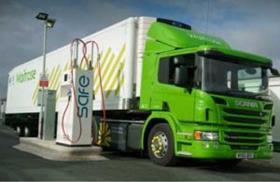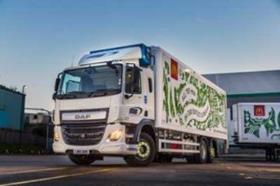By Christopher Walton and Colin Barnett
A Fuels in Action event at Kempton Park in Surrey last week (20 March) was the culmination of a year of activity from LoCITY featuring roadshows on gas, electric and hydrogen.
It brought together operators, manufacturers, fuel suppliers and policy experts to explore the multitude of options on the market.
Up for discussion were the latest developments and operational impacts across all alternatives to diesel, as well as the effect of legislation such as ultra-low-emission and clean air zones on freight movements.
There was also the latest in alternative fuel technologies on display, from the likes of Mercedes-Benz Trucks, Scania and Iveco – including an early outing for the FUSO eCanter.
Gas
The infrastructure and vehicle options for the widespread adoption of gas-powered commercial vehicles is there, delegates heard, but there is more to it than simply swapping diesel for gas in the tank.

In comparing the multiple options of gas fuels on the market, from LPG to LNG and CNG, James Westcott, business development director at Gasrec, said that the different types of gas would have different applications depending on the type of work the vehicle conducts.
For 3-axle artics, he believed LNG would be the best option “because that offers the range over long distances”. For refuse vehicles and the mid- to lower-rigid range that encompasses elements such as back-of-store deliveries, “CNG will have a greater impact”.
Westcott said that with major manufacturers bringing on 13-litre engine options, “this is almost parity with diesel, particularly when it comes to torque,” while 450hp gas vehicles will provide near parity when it comes to torque.
Fuel options also make a substantial difference to the total cost of ownership, explained TRL gas expert Tim Barlow. Citing the example of £600,000 to run a 36-tonne rigid averaging 10,000 miles annually over a seven-year period – including costs such as licencing, congestion charge, taxes, fuel, maintenance and depreciation – the use of CNG would reduce that cost by £80,000, LNG see £40,000 of savings, while LPG would see a saving of £8,000

Justin Laney, fleet manager, John Lewis – which runs a fleet of 53 gas-powered trucks – said that the legislative environment was also there to encourage take-up: “Fuel duty uncertainty was a big risk. If the Treasury increased the fuel duty [on gas] it would destroy the business case, but that is now fixed until 2024.”
Equally, on the John Lewis home delivery fleet, he said that the proposed 4.25-tonne arrangement for alternatively fuelled vans offered 50% extra payload and gives a business case straight away for the use of such vehicles.
In a separate session on gas, Adrian Heath, national accounts manager - transport, at Calor, discussed the possibilities for regional distribution into urban environments
He said that the concept is about to become reality in the shape of a 16-tonne rigid being built for Calor by Dutch specialist EMOSS on a Daf base, for use in delivering the firm's bottled gas products.
The truck's only direct drive is from electric motors powered by a battery pack giving a 40-mile range. Obviously this isn't enough for serious operations, and that range is extended to 250 miles by the use of a range-extending power unit. That unit is 2.0-litre Toyota engine running on LPG and designed to be used at a constant speed for maximum efficiency. It has no connection to the driveline, though, and is used solely to generate charge for the batteries.
Compared with a conventional diesel truck, the range-extended 16-tonner will initially cost 2.0 to 2.5 times as much, but Heath calculates that based on a seven-year service life, it will have a payback after four or five years, without accounting for any grants or incentives.
Using bio-LPG, which Calor is just beginning to supply, it combines ultra-low emissions with a CO2 reduction up to 94%. It will operate out of Calor's Coryton depot covering London and the south-east, and if successful, could be the first to replace up to 100 such vehicles on the Calor fleet.
Renewable fuels and retrofit options
Martin Brower, which handles McDonald’s logistics in the UK, has a target of reducing its fossil fuel usage by 80% by 2020, and believes its use of biodiesel – based on waste product from the restaurants it delivers to – will help it hit that target.
Speaking to delegates, Tony Winterbottom, GM - Operational Support, at Martin Brower said that when they set the reduction target back in 2007 they initially believed it would come from elements such as route optimisation and reducing fuel consumption caused by bad driving.
Servicing 1,369 McDonald’s locations in the UK and Ireland from four distribution centres, Martin Brower delivers some 70 million cases a year – and that is a volume of goods that has risen from 40 million cases a year back in 2007. As a result its fleet now runs 27 million km a year.
“We started a process in 2007 where we were bringing back waste from restaurants. We return 20,000 tonnes of cardboard, that was originally collected by waste contractors, but we do it on behalf of the restaurant. We also collect 3,500 tonnes of organic waste, 4,000 tonnes of grease trough waste and 4.2 million litres of used cooking oil.

“The used cooking oil we recycle. We turn it into biodiesel for our fleet and that is where the challenge started. We bring it back from all the restaurants and that 4.2 million litre produces 3.8 million litres of biodiesel,” Winterbottom added.
“Our projected biodiesel use is 7.7 million litres in 2018 - 8 million would be our target for an 80% reduction in fossil fuel use.”
The ultimate measure of carbon reduction though is CO2 output per cage delivery. For the optimum result, the best vehicle for carbon reduction is an artic, which has a CO2 output per cage delivery of 0.65. This is a result of the trailer capacity being 42 cages. A van can only carry four cages, so it takes 11 vans to do the work of one biodiesel-powered artic. For one van the CO2 output per cage delivery comes in at 5.24.
“We hear it all the time about these big vehicles entering the city causing air pollution, but maybe they are not quite as bad as you think,” he told delegates.
“We have actually set another target, now looking for a 51% reduction in CO2 emission reductions from our 2012 base by 2025. That is a stretching target but we will continue to reduce our reliance on fossil fuels.”
This approach will be encapsulated in a new livery on the fleet: ‘We recycle all our cooking oil to power this truck’.”
Electric
Improved collaboration between electric vehicle operators and electricity distributors will see a substantial increase of battery-powered vehicles on the roads of London.

Steve Halsey, distributed energy resources development manager at UK Power Networks – which owns, operates and maintains the electricity distribution in London, the east of England and south-east of England – said: “We predict we could end up with 8 gigawatts of electric vehicles on our network by 2030, that is about half of our current peak time demand.”
While he conceded that bus and taxi operators were leading the way in overall adoption, he did say that commercial vehicle operators were looking at innovations, citing the example of UK Power Network’s collaboration with UPS, which has seen it increase the number of vehicles running from its Camden depot from 65 to 170 on the back of improvements to recharging capabilities.
“The Camden UPS depot,” he said, “is the largest electric vehicle fleet in the UK. It required intelligent network analysis to release capacity.”
The move to electrification is being seen elsewhere in the capital and Vince Dignam, business improvement and performance manager at the City of London, said that the corporation was already trialling electric vehicles against diesel for refuse collection.
“We have just put our waste and cleansing contract out for tender, due to start two days before the ultra-low-emission zone comes in. It will be interesting to see what kind of technology they come back with,” he said.
Hydrogen
Hydrogen is, in theory, one of the best solutions for sustainable transport. However, progress towards widespread acceptance is slow, amid concerns over its availability and, more crucially, the environmental impact of the current manufacturing process.
A LoCITY Fuels in Action Roadshow session discussed the limitations of hydrogen as a fuel, as well as its benefits.
Hydrogen's use in commercial vehicles is as an energy storage medium, which is normally utilised as a complement to diesel in an internal combustion engine, or by reacting with a fuel cell to create electricity to provide motive power. It's relatively simple to manufacture and as easy to transport as diesel.
The only tailpipe emission of fuel cell vehicles is water, they have fewer moving parts, hence lower running costs and a hydrogen tank's 20-year life is only limited by legislation.

However great the benefits, though, you have to find the hydrogen. The investment in creating a private hydrogen producing facility is high, and the publicly accessible infrastructure is still in its infancy.
More significantly, the process of extracting hydrogen requires energy, and its overall environmental credentials are only as good as the source of that energy.
If electricity from truly renewable sources, such as the wind-powered installation of leading supplier ITM Power, at Rotherham, is used, the overall CO2 footprint is negligible, but most production still uses fossil fuel as the source.
Looking much further ahead, TRL's hydrogen specialist, Dr Anthony Velazquez, predicted a possible situation when the existing national gas supply network could carry hydrogen when fossil fuels are outlawed, but don't count on that just yet.














